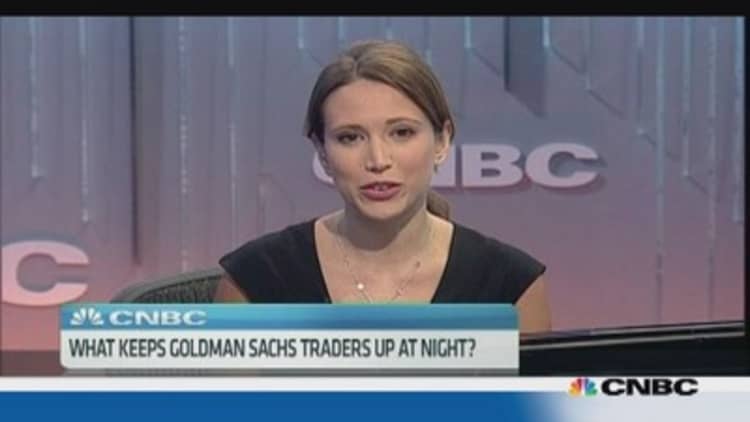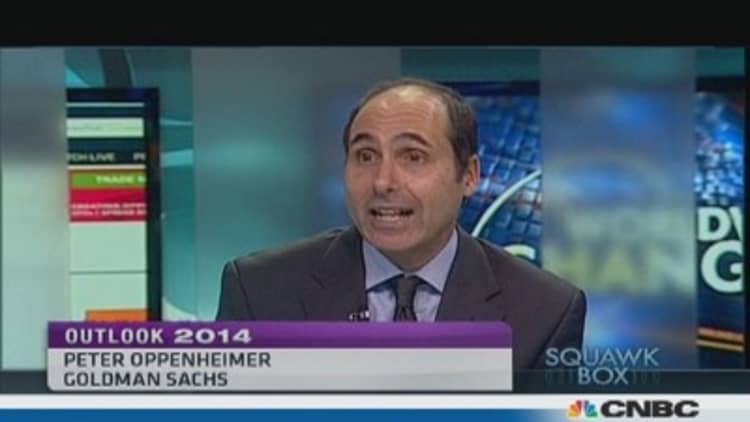
The market horizon may be relatively sunny, but Goldman Sachs sees five key reasons to remain a worrywart.
"The basic market outlook that we forecast is one in which equities and bond yields can continue to rise together and in which developed market assets continue to offer better risk-reward than their emerging market counterparts," Goldman said in a note.
But it added "although the mood in markets has turned more optimistic, we still encounter nervousness about the capacity for the outlook to remain positive."
(Read more: Goldman most upbeat on Japan, Europe stocks in 2014)
The bank sees five key risks:
1. The most likely risk is that long-dated yields could rise more sharply than expected in developed countries.
While inflation remains benign and the major central banks still look committed to keeping unusually low policy rates for a long period, the "unusually low" risk premium between long-term and shorter-term rates suggests increased risks, it said.
"Periods where yields rise rapidly – even with strong growth – tend to hurt equities, as during the taper tantrum," over the May-to-September period when markets convulsed after the Federal Reserve first broached the idea that it would taper its asset purchases, it said. "If yields rise because of expectations of tighter monetary policy, this is more unambiguously negative for equity markets."
2. As economic growth improves, markets may begin to doubt developed market central banks' commitment to easy money.
"Despite our expectations of a friendly Fed policy stance, stronger growth is likely to make it harder to stop markets worrying about an earlier rate hike," it said.
"Policymakers themselves may begin to sound less committed to prolonged easy policy as the recovery becomes more visible. That is clearly possible in the U.K. and U.S.," Goldman added. "But there is also a risk that the Bank of Japan may sound less committed to sustained asset purchases as inflation picks up. A premature focus on their exit strategy would pose a risk to bullish Japanese equity and bearish yen views."
(Read more: Goldman's Hatzius: Expect steady growth in 2014)
3. Low risk premia are also creating valuation challenges.
"As the expansion and market rally have progressed, risk premia have clearly fallen and equity valuations in particular are cited more often as a constraint," it said. "Return prospects are lower than they were coming into 2013."
4. Earnings margins could compress more rapidly as wages recover.
"We expect price inflation to be a touch higher than unit labor cost inflation, which has historically allowed firms to maintain or improve margins," Goldman said. But it added, "this depends on the assumption that wage growth will remain benign and implicitly that the labor market has plenty of slack."
With high margins offering a key support to U.S. equities over the last few years, "a more rapid tightening in the U.S. labor market represents the most significant risk to record-high margins."
(Read more: Goldman: Cut your emerging markets exposure by a third)

5. Goldman worries its cautious call on emerging markets might be wrong.
"The main risk to our own forecasts – and perhaps the markets too – would be that emerging market assets do better than their developed market counterparts, reversing some of the recent underperformance," it said.
"We may be underestimating the impact of an improving developed market demand picture on emerging market economic and market outcomes," it said, adding an improving external environment – and exports – could help alleviate deteriorating current account positions.
(Read more: Goldman predicts steep losses for gold in 2014)
In addition, emerging market assets are now trading at a notable discount to developed market peers and this may be enough to draw in investors, it said.
But in true worry-wart fashion, Goldman also sees a risk emerging markets could underperform its cautious view, citing rising U.S. yields, economic rebalancing, weaker China growth and upcoming elections.
To be sure, despite the worries, Goldman has "relatively high" confidence in its upbeat predictions.
—By CNBC.Com's Leslie Shaffer; Follow her on Twitter @LeslieShaffer1

